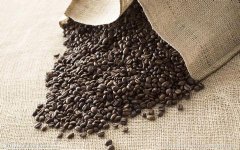Roasting is the "key" coffee base in coffee processing

The components of coffee quality (such as the quality and range of acidity and bitterness of coffee, the intensity and quality of aroma) are determined at the raw bean stage, although roasting can only adjust the taste within the range of characteristics of raw beans, but roasting has a greater impact on the taste of coffee than grinding and extraction, grinding and extraction is to transfer the roasted active ingredients to the coffee liquid, which has nothing to do with creating flavor.
During the roasting process, coffee bean cells mutate and carbohydrates, amino acids, proteins, lipids and minerals react. At 185240 ℃, sugars combine with amino acids, vitamin C and proteins for caramelization, which is the so-called "Mena reaction". The final product is yellowish brown, bitter sweet glycosylamine and melanin-like pigments. Thus giving more aroma to the coffee and ripe beans. The aroma of raw coffee beans contains about 250 different volatile molecules, while after roasting, as many as 800 volatile molecules can be found in coffee beans. Therefore, roasting is the most important link in coffee processing.
Important Notice :
前街咖啡 FrontStreet Coffee has moved to new addredd:
FrontStreet Coffee Address: 315,Donghua East Road,GuangZhou
Tel:020 38364473
- Prev

Vietnamese coffee pot concocted by Didi pot
Drinking coffee is a daily habit of Vietnamese. Vietnamese cafes are very common, not high-spending places, and ordinary ones are only a few yuan RMB. Vietnamese coffee is not brewed in a coffee pot, but is extracted into coffee by a special drip filtration method, which is used to pass the time. This kind of dripping filter is called dripping pot in Vietnam. This kind of coffee seems to be the only way to make coffee.
- Next

Comparison of Arabica beans and Robusta beans comparison of coffee beans
It is not difficult to distinguish between Arabica beans and Robota beans. You can easily tell the difference between Arabica beans and Robota beans by their appearance. The former is slightly oval and slender, and the central line (Center Cut) is S-shaped, while the latter is round and fat, and the central line is almost straight. For a detailed comparison, please refer to the table below, where Robusta contains almost twice as much caffeine as Arabica.
Related
- Beginners will see the "Coffee pull flower" guide!
- What is the difference between ice blog purified milk and ordinary milk coffee?
- Why is the Philippines the largest producer of crops in Liberia?
- For coffee extraction, should the fine powder be retained?
- How does extracted espresso fill pressed powder? How much strength does it take to press the powder?
- How to make jasmine cold extract coffee? Is the jasmine + latte good?
- Will this little toy really make the coffee taste better? How does Lily Drip affect coffee extraction?
- Will the action of slapping the filter cup also affect coffee extraction?
- What's the difference between powder-to-water ratio and powder-to-liquid ratio?
- What is the Ethiopian local species? What does it have to do with Heirloom native species?

